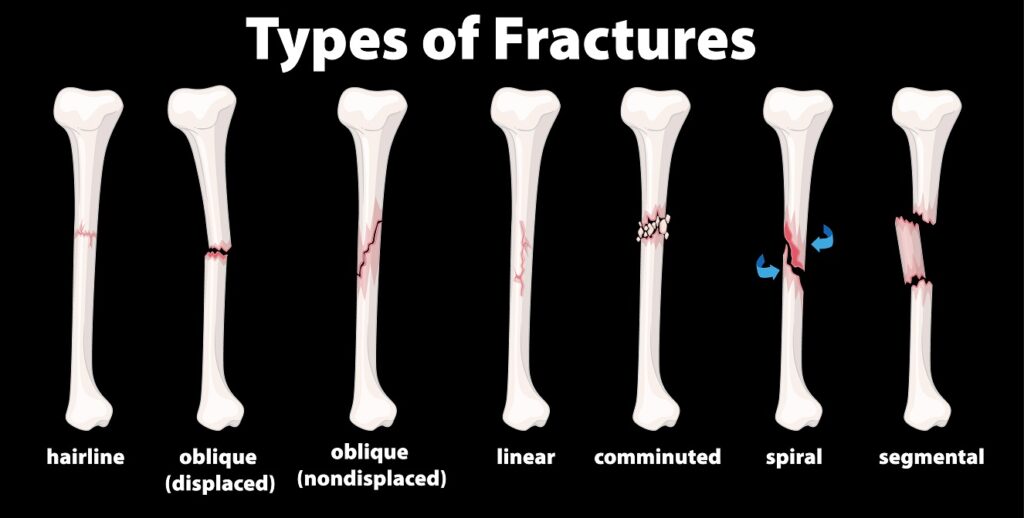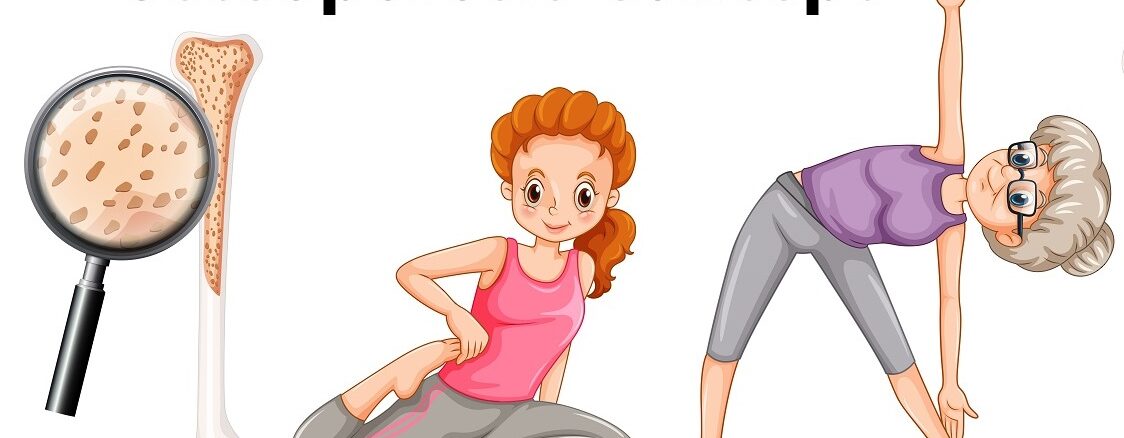Osteoporosis is a bone disease caused by a decrease in bone mineral density and mass, as well as a change in the quality or structure of bone. Bone illnesses have a significant impact on one’s ability to function. Many people with bone disease feel severe discomfort and loss of height, and they may lose their ability to dress, stand up, and walk.
Osteoporosis is known as a “silent” illness because it rarely causes symptoms, and you may not even realise you have it until you break a bone. Osteoporosis causes the bones to shrink and weaken. Your bones, particularly those in the hip, spine, and wrist, become frail and fracture (break) easily. In postmenopausal women and older men, osteoporosis is the leading cause of fractures. Millions of people in India have osteoporosis or are at high risk because of low bone mass.
The term “osteoporosis” literally means “porous bone.” It’s a bone-weakening sickness that puts you at a higher risk for unexpected bone fractures if you have it. Osteoporosis is defined as a loss of bone mass and strength. The disease frequently progresses without causing any signs of pain, and it isn’t detected until the weakening bones result in severe fractures.
Who Is At The High Risk Of Having Osteoporosis?
Each year, osteoporosis causes more than two million fractures, and the number continues to rise. The people on the list below are at a high risk of getting this disease:
- Women are much more prone than men to acquire osteoporosis.
- The risk of osteoporosis increases as you get older.
- If you’re white or Asian, you’re more likely to have osteoporosis.
- Some treatments or medicines, i.e., cancer medicines and glucocorticoid steroids may increase the chance of developing osteoporosis.
- You’re more likely to get osteoporosis if you have a parent or sibling who has it, especially if your mother or father has had a hip fracture.
- Those who have a low bone density.
- People with petite physical frames are at a higher risk because they may have less bone mass to draw on as they get older.
- Idiopathic juvenile osteoporosis is a rare form of osteoporosis that affects children and teenagers.
- Healthy lifestyle is crucial for bone health. Low amounts of physical activity and lengthy periods of inactivity can both contribute to bone loss.
- Chronic high alcohol consumption is a major risk factor for osteoporosis.
What Are The Symptoms Of Osteoporosis?
Osteoporosis is a disease that normally has no symptoms. However, there are a few things to be aware of:
- Height loss by an inch or more.
- Positional shift (stooping or bending forward).
- Breathing problems (less lung capacity due to bent spine).
- Bone fracture in a normal fall or accident
- Lower back pain
How Osteoporosis Can be Detected?
The diagnosis of osteoporosis usually entails multiple processes. Your osteoporosis and fracture risk will be properly assessed by a doctor. The following are the steps in diagnosing osteoporosis:
Asking About Medical History
A doctor will ask you questions about the risk factors for osteoporosis. You’re more likely to develop osteoporosis if you have a family history of the disease. Diet, physical activity, drinking habits, and smoking habits are all factors that can affect your risk. A doctor will also go through any medical issues you may have and any drugs you’ve taken. Any recent bone fractures, a personal history of back discomfort, a loss of height over time, or a stooped posture are all symptoms of osteoporosis that your doctor would likely inquire about.
Performing A physical Test
A doctor will take a measurement of a person’s height and compare it to prior ones. Osteoporosis can be detected by a loss of height. If you have trouble rising from a sitting position without using your arms to push yourself up, your doctor may inquire. They may test your blood to assess your vitamin D levels and do other blood tests to know your bones’ general metabolic activity. In the case of osteoporosis, metabolic activity may be increased.
Bone Density Test
You may have a bone density test if your doctor determines that you are at risk for osteoporosis. A dual energy X-ray absorptiometry (DEXA) scan is a common example. X-ray pictures are inexpensive and easily available methods used to determine bone density and fracture risk.
Blood And Urine Testing
Bone loss can be caused by a variety of medical disorders. These include problems with the parathyroid and thyroid glands. To rule this out, a doctor may do blood and urine tests. Calcium levels, thyroid function, and testosterone levels in men may all be tested.
The Chances of Having Fractures In The People With Osteoporosis

As a person gets older, the likelihood of some fractures rises considerably. Here are some statistics that will help you in determining the likelihood of fractures in patients with osteoporosis:
- Osteoporosis is responsible for an estimated 8.9 million fractures worldwide. This indicates that every three seconds, an osteoporosis-related fracture occurs.
- One in every three women over the age of 50 in the world will have an osteoporosis-related fracture. Men have a lower rate, with one in every five in the same age group suffering from an osteoporosis-related fracture.
- A person’s risk of a vertebral fracture is doubled if their bone mass in their vertebrae decreases by 10%. A person’s risk of fracture increases 2.5 times after losing 10% bone mass in the hip.
These figures clear out the notion that osteoporosis raises the risk of hip fractures. Women over 65 are especially vulnerable since their bones are thinner than men’s after they’ve gone through menopause. However, just because you have osteoporosis doesn’t indicate you’ll break a bone.
What Type Of Fractures Needs Surgery?

In some cases, surgery is required to treat a fracture. Many different types of fractures may have surgery in order to heal properly. The following are a few of the most common:
Femur (Thighbone) Fracture
A femur – or thigh bone – fracture is a common injury. To cure a fractured femur, internal fixation surgery is required. Generally, a surgical rod is used to help establish and support the bone as it heals. An orthopaedic surgeon may potentially use a plate to strengthen the rod. Open reduction and internal fixation (ORIF) of the femur is the full name of the procedure.
Shoulder Fracture
An orthopaedic physician may propose surgery to repair or replace the shoulder joint if the ball section of the upper arm is shattered, crushed, or split. If the muscles and tendons in the area were damaged during the injury, shoulder joint replacement surgery may entail muscle and tendon healing.
Hip Fracture
A hip fracture can be repaired using one of three methods:
Hip Repair- Hip repair entails using surgical screws, plates, rods, or nails to hold broken bones together. This procedure is known as “hip pinning”.
Total Hip Replacement Surgery- The whole joint, including the “socket” section of the pelvis, is replaced with a prosthesis in this procedure.
Partial Hip Replacement Surgery- The head of the thigh bone (the “ball” of the hip joint) is replaced with artificial pieces in this treatment. The “socket” section of the hip joint is not replaced in a partial hip replacement.
How Fractures Can Affect Our Lives?
A bone injury might make it difficult to maintain an active lifestyle. The following is a list of some of the most common effects of fractures on our life.
Strength Decrease And Discomfort Increase
Reduced strength around the fracture site is very common and can have a long-term effect on your health. If you break your ankle, for example, you may notice that this area isn’t as strong as it previously was, and you can’t move it, walk, or jump as well as you once could. Even after a fracture has healed entirely, you may suffer soreness in the location where it occurred.
Joint Issues
Although fractures are a bone injury, they can also cause damage to the muscles, joints, and ligaments surrounding the bone. The cartilage at the ends of the bones, known as the joint or joint surfaces, is damaged by these traumas. This area is normally smooth, but when cartilage is damaged, it develops scars, which can lead to osteoarthritis. As a result, your joints may become stiff and your range of motion may be limited. Joint pain is most typically felt in the shoulders, knees, and elbows.
Anxiety And Depression
Any serious physical damage can result in significant psychological distress. You may encounter a variety of psychological disorders depending on the severity of the fracture and how it has affected your life. Depression, anxiety, tension, and nightmares are examples of these. Mental and emotional symptoms can have a significant influence on your entire health if they are not addressed appropriately and treated as a serious concern.
Nerve damage
When a bone is harshly injured, nerve damage might result. Nerves can be stretched, squashed, or injured in various ways. This is frequently the outcome of blunt force injuries. Nerve injury usually heals on its own, although it can take weeks, months, or even years, depending on the extent of the damage. Unfortunately, some nerve damage never fully heals, leaving a long-term consequence. Nerves can be torn as well. Sharp bone shards touching nerves after a break can cause this form of damage, which is most likely to occur when the skin is torn.
Inability To Participate In Certain Activities
It may be difficult to return to the same level of physical activity as before the accident, depending on the nature and severity of the fracture. This isn’t always the case, as it is contingent on the extent of the damage to the surrounding areas. It is possible, though, that it will have a long-term impact on your life.
Fractures are frequently dismissed as minor injuries that would heal on their own. They can, however, be serious and distressing at times, and have a long-term impact on your health and well-being. You can reduce the risk of long-term fracture consequences with therapy and correct treatment.
Steps To Prevent Osteoporosis
Osteoporosis is a dangerous disease that is frequently ignored until it is too late. Low bone mass and structural degeneration of bone tissue are prominent symptoms of the condition. Fortunately, there is a lot you can do to avoid osteoporosis, strengthen your bones, and enhance their health. The following is a list of Osteoporosis preventative steps.
Get The Calcium And Vitamin D Everyday
The average adult should consume 1,000 mg of calcium every day. If you’re over 70 or 50 years old, though, you should aim for 1,200 milligrammes. You may be able to receive most of the calcium you need from your diet and rest with supplements if you eat a well-balanced diet.
Vitamin D is necessary for the absorption of calcium and for the protection of bones. If you’re 70 or younger, your daily vitamin D aim should be 600 international units (IU), and if you’re 71 or older, it should be 800 IU. Because many women do not get enough vitamin D from sunlight and food, supplements may be required to achieve this aim.
Exercise Your Bones
Weight-bearing workouts such as dancing, hiking, treadmill walking, or low-impact aerobics help to build and maintain strong bones. Exercises that build muscles, such as lifting weights or yoga and Pilates, can assist increase bone strength, balance, and flexibility.
Eat Foods That Are Good For Bone Health.
Calcium is present in dairy products, dark leafy greens, fortified drinks, and cereals. Vitamin D is present in fatty fish such as salmon, tuna, and sardines. Magnesium is present in sweet potatoes, tomato products, and artichokes.
Quit Smoking And Drinking Alcohol
Smoking has been established as an osteoporosis risk factor. Tobacco smoking has been linked to a decrease in bone density in several studies. Quit drinking alcohol or limit its consumption to no more than 2 to 3 drinks.
Summary
To summarise, osteoporosis causes bones to become weak and brittle, to the point that even minor stressors like bending over or coughing can result in a fracture. The hip, wrist, and spine are the most prevalent sites for osteoporosis-related fractures. Osteoporosis can be avoided in some circumstances. The earlier you start taking care of your bones, the better your body will be In your 50s and beyond.


